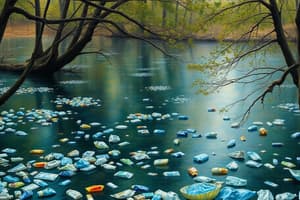Podcast
Questions and Answers
Why are young people considered to be significantly impacted by the environmental issues caused by older generations?
Why are young people considered to be significantly impacted by the environmental issues caused by older generations?
- Young people have a lower tolerance for air and water pollution compared to older adults.
- The consequences of environmental damage, such as climate change and resource depletion, will primarily affect the younger generations who will live with them longer. (correct)
- Young people generally have fewer pre-existing health conditions, making them more prone to environmental hazards.
- Older generations are more likely to migrate away from areas affected by climate change, leaving young people to deal with the problems.
What is the correlation between deforestation and climate regulation?
What is the correlation between deforestation and climate regulation?
- Deforestation causes the release of oxygen into the atmosphere, which counteracts the effects of greenhouse gases.
- Deforestation has no significant impact on climate regulation, as forests only play a minor role in global climate patterns.
- Deforestation leads to a decrease in the amount of carbon dioxide absorbed from the atmosphere, disrupting the climate's balance. (correct)
- Deforestation results in an increase in local rainfall, which helps to cool the surrounding environment.
How does plastic pollution contribute to climate change?
How does plastic pollution contribute to climate change?
- Plastic waste reflects sunlight back into the atmosphere, increasing global temperatures.
- Decomposing plastic releases methane, a potent greenhouse gas, into the atmosphere.
- Plastic pollution reduces the ocean's capacity to absorb carbon dioxide from the atmosphere.
- The production and incineration of plastic release greenhouse gases, contributing to climate change. (correct)
Which of the following describes how water shortages affect education, particularly for young girls, in many parts of the world?
Which of the following describes how water shortages affect education, particularly for young girls, in many parts of the world?
What is the projected impact of an 8-degree Fahrenheit increase in the Earth's average temperature by 2100, as predicted by the IPCC?
What is the projected impact of an 8-degree Fahrenheit increase in the Earth's average temperature by 2100, as predicted by the IPCC?
Why are young people more vulnerable to the effects of air pollution?
Why are young people more vulnerable to the effects of air pollution?
Which action would be LEAST effective in reducing personal contributions to air pollution?
Which action would be LEAST effective in reducing personal contributions to air pollution?
If a community aims to mitigate the impact of habitat destruction on local biodiversity, which strategy would be most effective?
If a community aims to mitigate the impact of habitat destruction on local biodiversity, which strategy would be most effective?
Approximately what percentage of the global population is made up of young people (under 35)?
Approximately what percentage of the global population is made up of young people (under 35)?
What is the main cause of more frequent and intense droughts, leading to water shortages that disproportionately affect young people?
What is the main cause of more frequent and intense droughts, leading to water shortages that disproportionately affect young people?
Flashcards
Climate Change Impacts
Climate Change Impacts
The Earth’s average temperature has increased by about 1.5 degrees Fahrenheit since pre-industrial times, leading to melting ice, rising sea levels, and extreme weather.
Plastic Pollution
Plastic Pollution
Millions of tons of plastic waste enter the ocean annually, harming marine life, polluting water, and entering the food chain.
Water Shortages
Water Shortages
Droughts are becoming intense due to climate change, reducing water for drinking, cooking and hygiene and disproportionately affecting young people, especially women responsible for water collection.
Habitat Destruction
Habitat Destruction
Signup and view all the flashcards
Air Pollution
Air Pollution
Signup and view all the flashcards
Reduce fossil fuel use
Reduce fossil fuel use
Signup and view all the flashcards
Conserve energy
Conserve energy
Signup and view all the flashcards
Recycle and compost
Recycle and compost
Signup and view all the flashcards
Study Notes
- Young people (under 35) comprise over 50% of the world's population.
- Youths aged 15-25 account for more than 16% of the global population.
- In developing nations, young people may constitute over 75% of the population.
- Young people play a crucial role in addressing climate change, often leading activism and demanding action.
- Climate change disproportionately affects young people.
Top 5 Youth Environmental Issues
- Include climate change, plastic pollution, water shortages, habitat destruction and biodiversity loss, and air pollution.
Climate Change
- The Earth’s average temperature has risen by roughly 1.5 degrees Fahrenheit since pre-industrial times, according to the IPCC.
- By 2100, the Earth could warm by as much as 8 degrees Fahrenheit if greenhouse gas emissions are not reduced.
- The effects of climate change include melting Arctic ice, rising sea levels, and more frequent extreme weather events.
Plastic Pollution
- Plastic waste accumulates in the ocean, harming marine life and polluting water sources.
- A garbage patch exists in the Pacific Ocean, measuring 1.6 million square kilometers and consisting mostly of plastics.
- Plastic pollution contributes to greenhouse gas emissions, exacerbating climate change.
Water Shortages
- Climate change contributes to increasingly frequent and intense droughts.
- Water scarcity can lead to dehydration and illness, especially affecting children.
- Women and girls often bear the responsibility of water collection, impacting their education.
Habitat Destruction and Biodiversity Loss
- Deforestation results in habitat loss, impacting climate regulation and biodiversity.
- Forests are being destroyed at a rate of 30 football fields per minute, according to the World Wildlife Fund.
- Habitat loss can lead to flooding, wildfires, soil erosion, and species extinction.
Air pollution
- 92% of the world’s population lives in areas exceeding safe air quality levels, according to WHO.
- Air pollution can cause respiratory infections, asthma, heart disease, and cancer.
Actions to Reduce Environmental Impact
- Reduce fossil fuel use by walking, biking, carpooling, and using public transportation.
- Conserve energy by turning off unused lights and ensuring good insulation.
- Recycle and compost to reduce landfill waste and methane emissions.
Studying That Suits You
Use AI to generate personalized quizzes and flashcards to suit your learning preferences.





